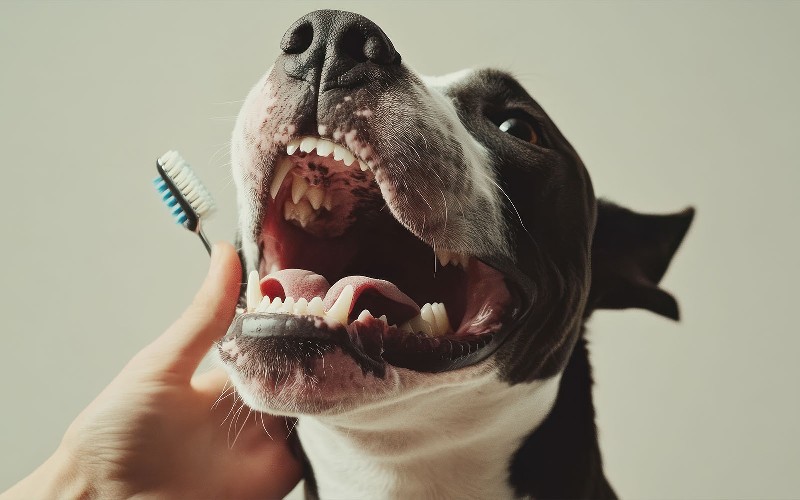
Dog bad breath: How to manage your way to fresher kisses from your pooch
There’s nothing quite like coming home after a long day and being greeted by your dog’s affectionate, sloppy kisses. But wouldn’t it be even better if your pooch’s breath smelled fresher? Many believe that bad breath is just part of being a dog— but is it really?Contrary to popular belief, bad breath in dogs isn’t something you should just accept. In fact, it can be a sign of poor dental hygiene or even an indicator of underlying health issues that need veterinary attention.
In this article, we’ll dive into some of the most common causes of bad breath in dogs and how to manage it, so those loving kisses are nothing but sweet.
Common causes of bad breath in dogs
1. Poor oral hygiene and periodontal disease
The most common cause for bad breath in dogs is most likely poor oral hygiene. Just like humans, even dogs can build up plaque and tartar, leading to the unpleasant odors you encounter when your furry friend gives you kisses.
Over time, this buildup can lead to periodontal disease. Excess plaque and tartar push the gums away from the teeth, creating pockets where bacteria thrive. This not only causes gum inflammation but can also result in infections, tissue damage, tooth loss, and even pus formation. Needless to say, it makes your dog's breath smell far worse.
2. Something stuck in their teeth
If teeth brushing isn’t regularly performed on your four-legged family member, chances are that his foul breath is caused by something stuck in his teeth. This includes anything from food debris to foreign objects like sticks. If you suspect a foreign object is lodged in your dog's teeth, a visit to the vet may be necessary for safe removal. For regular cleaning, make it a habit to brush your dog’s teeth at least three times a week to prevent debris buildup and improve their breath.
3. Digestive issues
Bad breath can also be a result of digestive problems, especially if your dog has other symptoms like flatulence or loose stools.
If digestive issues have been already confirmed, check with your Farmina Consultant if N&D Quinoa Digestion is the correct match for your pet. A highly digestible formula to support the intestinal wellbeing of pets dealing with digestive sensitivities.
Find out more
4. Nasty dietary habits
Some dogs have very nasty habits, such as roaming through the garbage, eating roadkill or even feces, which as a consequence translate into bad breath.
You can help curb these habits through proper training and positive reinforcement. If you catch your dog munching on something unsavory, don’t resort to scolding; instead, guide them with gentle correction and discipline.
5. Underlying health issues
Unfortunately sometimes bad breath isn’t simply due to poor dental hygiene and dietary habits. In fact, it may be due also to underlying health issues such as diabetes and liver or kidney diseases.
Each of these conditions tends to have a distinct breath odor:
- Diabetes: Breath may smell sweet or fruity.
- Kidney Disease: Breath may have a urine-like odor.
- Liver Disease: Breath may smell particularly foul and may be accompanied by vomiting, loss of appetite, and yellowing of the gums.
Managing bad breath
If you want to enjoy fresher kisses from your dog and support their overall health, it’s essential to take action based on the root cause of their bad breath. Here’s how:
- Talk to your vet
This will help you understand the root cause of the issue and rule-out any underlying health issue.
Your vet can also recommend a treatment plan tailored to your dog’s specific needs.
- Create a brushing routine
Regular brushing can help fight plaque and tartar build up, as well as remove any residuals between your pet’s teeth. If your routine doesn’t allow for a daily cleaning, try to reach at least 3 times per week, as suggested by most vets.
For cleaning you will simply need a toothbrush and toothpaste specifically designed for dogs. Avoid using products designed for human consumption as they may be harmful for pets.
- Dental Treats
If brushing daily isn’t feasible, dental treats can help keep your dog’s mouth cleaner between brushings. Dental treats are designed to reduce plaque and tartar while refreshing your dog’s breath, but they should complement, not replace, regular brushing and a balanced diet.
If you are searching for a dental treat that helps improve your pup’s dental hygiene while taking care of your pet’s nutritional needs, look no further! Try one of the many Farmina Dental and Functional Treats. Available in 6 lines, each with a specific function to meet the specific needs of every beloved companion, including those on a clinical diet.
Find the perfect cuddle for your pet’s smile.
- Talk to a Farmina Consultant
If your dog’s bad breath is linked to digestive issues or an improper diet, reach out to your Farmina Consultant, who will guide you in managing the issue and help you determine the most suitable diet for your pet’s unique needs.
Request Nutritional Support
As we've seen, bad breath doesn’t have to be a constant presence in your dog’s life. With proper care, even your pooch can greet you with fresh, slobbery kisses. By consulting your vet, adjusting their diet, and maintaining a regular brushing routine, you can ensure that your dog’s kisses are sweeter than ever.

